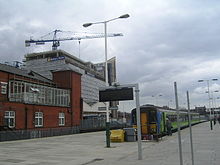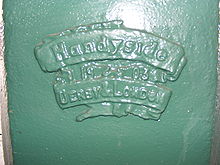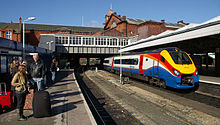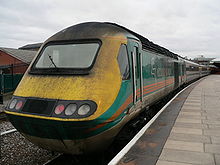- Nottingham railway station
-
Nottingham 
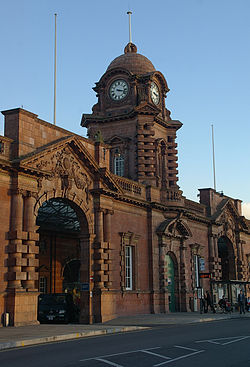
Location Place Nottingham Local authority Nottingham Coordinates 52°56′49″N 1°08′46″W / 52.947°N 1.146°WCoordinates: 52°56′49″N 1°08′46″W / 52.947°N 1.146°W Operations Station code NOT Managed by East Midlands Trains Number of platforms 6 Live arrivals/departures and station information
from National Rail EnquiriesAnnual rail passenger usage 2004/05 *  5.477 million
5.477 million2005/06 *  5.371 million
5.371 million2006/07 *  5.770 million
5.770 million2007/08 *  5.891 million
5.891 million2008/09 *  6.793 million
6.793 million2009/10 *  6.219 million
6.219 millionHistory Opened 22 May 1848 16 January 1904 New building opened National Rail - UK railway stations A B C D E F G H I J K L M N O P Q R S T U V W X Y Z * Annual passenger usage based on sales of tickets in stated financial year(s) which end or originate at Nottingham from Office of Rail Regulation statistics. Please note: methodology may vary year on year. Nottingham station, for some time known as Nottingham Midland or Nottingham City, is the principal railway station of the city of Nottingham and the Greater Nottingham area. It is served by East Midlands Trains, CrossCountry and Northern Rail; prior to 11 November 2007, it was served by Midland Mainline and Central Trains.
Contents
History
The first station
The first Nottingham station (1839–1848) opened in May 1839 when the Midland Counties Railway opened the line from Nottingham to Derby. This terminus station was situated on the west side of Carrington Street on the site now occupied by Nottingham Magistrates' Court. The original station gate posts still exist and form the pedestrian entrance to the Magistrates' Courts area.
The second station
In 1844 the Midland Counties Railway merged with two others into the Midland Railway and by 1848 it had outgrown this station and new lines to Lincoln had been opened. A new through station (1848–1903) was opened on Station Road on 22 May and was designed by the architect J E Hall of Nottingham. In the 1880s Nottingham station employed 170 men. Although attractive when it first opened, by the early 1900s the station was cramped, with only three platforms. A locomotive derailment knocked down a cast iron pillar, which brought down part of the train shed. This and the new Victoria station putting the Midland Railway to shame finally resulted in a scheme to re-build and expand.
Current building
When the Great Central Railway opened its Victoria Station in 1900, the Midland Railway appointed Albert Edward Lambert, a local Nottingham architect, to rebuild the Midland station. Lambert had been the architect for the Nottingham Victoria railway station and consequently the two buildings shared many similarities in their design.
The station was re-built largely on the same site as the Station Street station, but the entrance was relocated onto Carrington Street.
The first contract for the station buildings was awarded to Edward Wood and Sons of Derby on 23 January 1903, who were also awarded the contract for the buildings on platforms 1 and 2 on 16 September 1903. The contract for the buildings on platforms 4 and 5 was awarded to Kirk, Knight & Co of Sleaford on 18 June 1903, who were also responsible for building the parcels office (Forward House) on Station Street, which opened in November 1903. The structural steelwork and cast-ironwork was done by Handyside & Co. and the Phoenix Foundry, both of Derby.
The station was built in an Edwardian Baroque Revival style at a cost of £1 million (£79,620,000 as of 2011),[1] and was described by the Evening News on the eve of its opening (16 January 1904) as a magnificent new block of buildings.
The station was built using a mix of red brick, terracotta (which was used as a substitute for building stone) and faience (a glazed terracotta) with slate and glazed pitch roofs over the principal buildings. The carriage entrances have Art Nouveau wrought-iron gates
The station’s forebuildings were opened to passengers without any formal ceremony on 17 January 1904, although next day the Evening News reported that the platforms were still in a state of chaos and these were not expected to be ready for another nine months. However it did consider that ‘the result promises to be the provision for Nottingham of one of the most commodious and most convenient passenger stations in the country’.
The day began with the closure of the booking offices in the old station after the last tickets were issued for the 5:25 am London train and the new booking offices were opened in time to issue tickets for the 6:25 am Erewash Valley train. No attempt was made to exclude the public from the building and many took the opportunity to view the new station buildings. The Evening News commented on the public’s admiration of the style and elegance of the station approaches and booking hall and went on to describe the day’s events. In the morning, local juveniles swarmed into the station and spent their time playing boisterous games and dodging the duty policeman. Then later in the day, when the juveniles had finally been excluded, many top-hatted gents and their ladies came to promenade, no doubt adding some decorum to the proceedings, and to look at the architecturally pleasing buildings and general satisfaction was expressed. Finally as evening approached the gates were closed and none but passengers were allowed inside.
The Midland Railway always suffered the indignity that its rival the Great Central Railway crossed the top of Nottingham Midland station on a 170-foot-long (52 m) bowstring girder bridge. This became redundant in 1967 and was finally dismantled in the early 1980s. Plans exist to build a new tramway bridge over the station on the same alignment.
Other Nottingham stations
The Great Central Railway station was Nottingham Victoria. The Great Northern Railway stations were the high level and low level stations in London Road. For a brief period (1967–1969) Nottingham Victoria station having closed, the service from Nottingham to Rugby Central used a reopened Arkwright Street station (previously closed in 1963).
Nottingham station today
There are plans to redevelop the station which include more shops and Nottingham Express Transit trams running over the top of the station. [1]
The station has six platforms. Platforms 1, 3, 4, 5 and 6 are halved into A and B to accommodate two trains on each platform.
Platform 1 is used mainly for trains to Lincoln Central. Semi-fast services from London St Pancras terminate at this platform. Some CrossCountry trains services to Birmingham New Street and Cardiff Central call at the platform also.
Platform 2 is a bay platform at the eastern end of the station which accommodates terminating trains from Newark and Grantham directions but mainly the hourly East Midlands Trains (EMT) service to Skegness via Boston.
Platform 3 is used by a variety of services, EMT local trains to Derby & Matlock, long distance EMT services to Norwich via Grantham, Peterborough, Ely & Thetford, early morning EMT services to London St. Pancras and Northern Rail services to Leeds via Sheffield & Barnsley.
Platform 4 is mainly used for the EMT fast service to London St. Pancras via Leicester and Market Harborough, including EMT local services to Mansfield Woodhouse and Worksop.
Platform 5 is commonly used for trains to Liverpool Lime Street, calling at Alfreton, Chesterfield, Sheffield, Stockport, Manchester Piccadilly, Manchester Oxford Road, Warrington Central, Widnes and Liverpool South Parkway and by CrossCountry trains to Birmingham New Street.
Platform 6 is commonly used for Ivanhoe Line trains to Leicester and also by certain Birmingham and Cardiff CrossCountry trains.
About 15,000 people pass through the station each day.[citation needed] Station Street tram stop is connected to the station concourse via a pedestrian bridge.
The station has the PlusBus scheme where train and bus tickets can be bought together at a saving. It is in the same area as Beeston, Bulwell, Netherfield and Carlton stations.
As part of remodelling the station, there are plans to redevelop and refurbish it. The first refurbishment is to reconstruct the railway bridge. It was refurbished with repainting and stronger supports. It cannot be demolished because it is a Grade II* listed building.[2] Next was to construct a First Class lounge. It was constructed by Network Rail and funded by East Midlands Trains and Nottingham City Council. It was opened on 14 December 2008, when the timetable change commenced. Nottingham City Council planned to construct a multi-storey car park. There were protests not to construct the car park because of taking natural light from the station. Plans were to reconstruct the whole station. This includes the ticket office, main concourse and the platforms. The council want to call the station The Hub. During May 2009, work started to construct automatic ticket gates at Nottingham station. As of late 2009 Nottingham is a Penalty fare station.
Train Services
- London services, XC services
The following services currently call at Nottingham:
Services
Network Rail plan to spend £100m on track improvement schemes on the Midland Main Line, which will cut the journey time from 104 minutes to 90 minutes by 2011 between London and Nottingham.[3]
Current off-peak services from the station include:
1tph to London St Pancras (fast) via East Midlands Parkway, Leicester and Market Harborough (East Midlands Trains)
1tph to London St Pancras (slow) via Loughborough, Leicester, Kettering, Wellingborough, Bedford and Luton Airport Parkway (East Midlands Trains)
1tph to Liverpool Lime Street via Sheffield, Manchester Piccadilly and Warrington Central (East Midlands Trains)
1tph to Norwich via Grantham, Peterborough and Ely (East Midlands Trains)
2tph to Mansfield Woodhouse, with 1tph continuing to Worksop (East Midlands Trains)
1tph to Skegness via Boston (East Midlands Trains)
1tph to Leicester via Loughborough (East Midlands Trains)
1tph to Lincoln via Newark Castle (East Midlands Trains)
1tph to Matlock via Derby (East Midlands Trains)
2tph to Birmingham New Street via Derby with 1tph continuing to Cardiff Central via Newport (CrossCountry)
1tph to Leeds via Sheffield (Northern Rail)
There is also an early morning service to Bournemouth via Birmingham New Street, Reading and Southampton provided by CrossCountry. This service departs at 06:37.
Glasgow Trains are looking into possibilities of running a direct service from Nottingham to Glasgow Central. Their plans have yet to be approved, however.
Preceding station  National Rail
National RailFollowing station CrossCountry Cardiff–NottinghamTerminus East Midlands Trains Terminus East Midlands Trains Terminus East Midlands Trains Limited ServiceLimited ServiceEast Midlands Trains Liverpool-NorwichTerminus Limited ServiceEast Midlands Trains Nottingham-NorwichTerminus Terminus East Midlands Trains Nottingham-SkegnessBulwellEast Midlands Trains Terminus East Midlands Trains Terminus Terminus Northern Rail Nottingham-LeedsLimited ServiceTrivia
Punk band The Clash played a gig at Nottingham station as part of their 'Back to Basics' busking tour in the mid-eighties. The gig took place at midnight.[citation needed]
References
- ^ UK CPI inflation numbers based on data available from Lawrence H. Officer (2010) "What Were the UK Earnings and Prices Then?" MeasuringWorth.
- ^ "Midland Railway Station". Listed Buildings Online. http://lbonline.english-heritage.org.uk/BuildingDetailsForm.aspx?id=454892&search=y. Retrieved 2010-02-28.
- ^ "125MPH TRAINS TO CUT JOURNEY TIMES". Nottingham Evening Post. 12 April 2008. http://www.thisisnottingham.co.uk/displayNode.jsp?nodeId=134487&command=displayContent&sourceNode=134482&contentPK=20380020&folderPk=78489&pNodeId=134461.
External links
- Nottingham Train Station Information
- Nottingham Car Parking
- Nottingham Cheap Train Tickets
- Nottingham Train Station - The Open Guide to Nottingham
- See Nottingham railway station on Google Street View.
Major railway stations in Britain Managed by Network Rail: Managed by train operator: Brighton • Bristol Parkway • Bristol Temple Meads • Cardiff Central • Cardiff Queen Street • Crewe • Doncaster • Glasgow Queen Street • Manchester Victoria • Newcastle • Nottingham • Reading • Sheffield • Southampton • YorkManaged by Network Rail: Managed by train operator: Blackfriars • Clapham Junction • City Thameslink • Marylebone • Moorgate • Stratford • Waterloo EastCategories:- Buildings and structures in Nottingham
- Railway stations in Nottinghamshire
- Former Midland Railway stations
- Railway stations opened in 1839
- Railway stations closed in 1848
- Railway stations opened in 1848
- Railway stations served by East Midlands Trains
- Railway stations served by CrossCountry
- DfT Category B stations
- Grade II* listed buildings in Nottinghamshire
- Grade II* listed railway stations
Wikimedia Foundation. 2010.

